Term archive

投稿タイプ:info-centers-list
Kyoto Miyama Tourism Association

投稿タイプ:restaurants
Ninokichi
Ninokichi was founded in 1981 in Fukuchiyama, where a meat-eating culture has taken root. Currently, the restaurant is run by its second generation owner, Mr. Shinya Otsuki, and it's attracted attention for its French-based meat dishes, particular about their quality.
Quality is the top priority for beef used at Ninokichi. Beef here is sourced from far and wide, from local sources to as far as Kyushu in southern Japan, all to carefully select the best ingredients attainable at the time. The chef oversees most of the process, from aging to cutting, ensuring nothing gets overlooked in the pursuit of the best taste. Furthermore, as you can see by the beautiful presentation of the meat dishes here, Ninokichi is defined by the creative presentations of Mr. Otsuki, with his background in French cuisine. Unique menu items have included dishes such as smoked deer and bagna càuda dip, which many customers have enjoyed paired with wine. At Ninokichi, you're sure to find some surprising deliciousness in the mix of grilled meat and French-style cuisine.
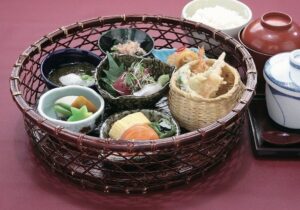
投稿タイプ:restaurants
Yurari Yura-gawa
Founded in 1902, Yurari Yura-gawa was opened in 1996 by relocating a more than 100 year-old home from Tsuruga City, Fukui Prefecture to its current location, looking out on the gentle flower of the Yura-gawa River and operating as a sister establishment to Dining Ryokan Inn Fushimi-ya.
Relax at a counter seat or Japanese-style room looking out at the scenery, or in the calming atmosphere of a sunken fireplace or attic room.
Important concepts for the food here are the ingredients, and charcoal-grilling.
Enjoy seasonal ingredients like wild Tamba plants and Wakasa seafood prepared Japanese-style.
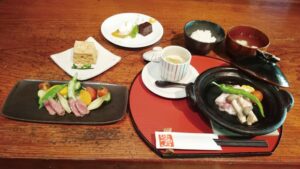
投稿タイプ:restaurants
Yururi
Yururi's standard course is composed of fresh vegetables, food grilled on the hearth, local Miyama chicken with seasonal rice, dessert, and coffee.
Depending on the season, they also serve Miyama sweetfish salt-grilled on the hearth and sukiyaki prepared with local chicken.
Enjoy a sense of the seasons, and the slow flow of time as you dine here.
Reservations are required at Yururi, so please be sure to call in advance.
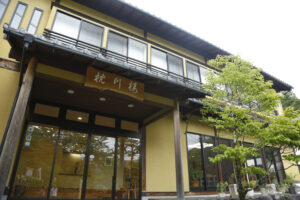
投稿タイプ:restaurants
Chinsenro
Over 110 years, flowing endlessly like the Miyama-kawa River.
Guests to Chinsenro are welcomed with a warm and calming hospitality, so that you, too, can enjoy the gentle flow of time.
Chinsenro uses local ingredients from the mountain country, and has devised preparation methods that don't spoil any of their natural flavors.
All rooms face the Miyama-kawa River, and have excellent views.
Relax, and enjoy the sound of the flowing river.
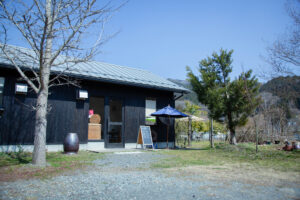
投稿タイプ:restaurants
Bio Sweets Capocapo
Bio Sweets Capocapo is a confectionary workshop with a small café in Kyotamba, in central Kyoto Prefecture. Encircled by mountains and rich natural surroundings, and looking out on the Yura-gawa River, Capocapo produces simple sweets with carefully-selected organic, pesticide-free ingredients for the Kansai area and across Japan, made here in Kyotamba where you can see the face of the confectioners.
Capocapo may decide, from the farmer's standpoint, to use fruits and vegetables even if they are not completely organic. Selecting ingredients based on face-to-face relations will result in more deliciousness. Capocapo believes that choosing organic not because it's healthy, but because it's the choice to live in coexistence with nature, it has a natural deliciousness that will bring health to both mind and body.
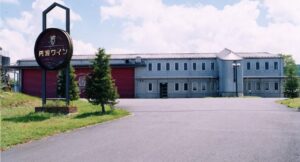
投稿タイプ:restaurants
Tamba Winehouse Vineyard Grill
This garden terrace café looks out over the grape vines of the Kyoto Tamba Winery vineyard.
The vineyard grills uses local produce in an effort to adhere to a concept of local production for local consumption. Guests can enjoy wine as they leisurely grill local ingredients.
Dogs and other pets are allowed.
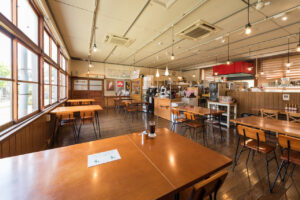
投稿タイプ:restaurants
Pandozo Café
Pandozo Café is an oven-baked pizza and raw pasta restaurant inside Old Shitsumi Elementary School in Kyotamba-cho, Kyoto Prefecture.
The café opened inside this former elementary school (closed in March, 2011) in April, 2013.
Guests can enjoy our prized oven-baked pizza and raw pasta in the retro interior of this old wooden schoolhouse dating back to 1960.
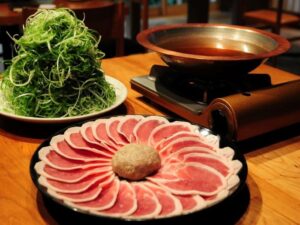
投稿タイプ:restaurants
Yanagimachi
Yanagimachi is a famous restaurant in Fukuchiyama that showcases Fukuchiyama’s specialties of duck and green onion in a dish known as kamosuki (sukiyaki made with duck meat). The restaurant building is a restored Meiji era (1868-1912) machiya (traditional wooden house, typical of Kyoto) opened in 2015. The dishes showcase local and seasonal produce, and the green onion used in the kamosuki is Fukuchiyama’s own kujo onion (a famous vegetable of the Kyoto region). For lunch, you can enjoy wonderful oyakodon (rice topped with chicken and egg) or kara-age (fried chicken) set meal options, both made using the local Fukuchiyama chicken, and accompanied with seasonal local vegetables. There’s also a select range of alcohol, coffee, and books to enjoy at the café and bar, making it a perfect spot for any occasion.
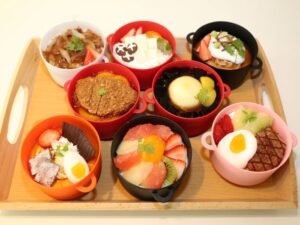
投稿タイプ:restaurants
Un.donpuri Dessert Shop
Located in Fukuchiyama City, Un.donpuri is a café known for its for puddings that look amazingly like Japanese cuisine. It has puddings in the form of 11 kinds of dishes: katsudon (fried pork cutlet on rice), ramen, seafood bowls, tororodon (grated yam rice bowl), mapo tofu (Sichuan-style bean curd with ground pork spicy taste), Japanese hot pot, beef bowl, loco moco, cold sweet red bean soup, wonton noodles, and Chinese style cold noodles (summer only), each sold for 600 yen including tax. They are not only delicious to taste, but also enjoyable to look at. The idea began when the pastry chef created a pudding that looked like katsudon as a gift for a friend, which later went viral on social media. In addition to the puddings, cakes and baked sweets like cute donuts and cookies for takeout are lined up in the showcase window (there is also an eat-in space within). The pudding containers are made of polypropylene, which is microwavable and can be taken home to use for other purposes. The café is now a famous attraction in Fukuchiyama for sweets-lovers, and while the cafe opens at 11 a.m., the 80 bowls of pudding prepared on weekdays and 120 on weekends are often sold out early.
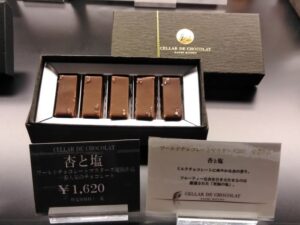
投稿タイプ:restaurants
Pâtisserie Mountain × CELLAR DE CHOCOLAT by Naomi Mizuno
A classical European-style mansion situated in a quiet, residential part of Fukuchiyama City, looking like a confectionery kindom on the outskirts of Paris. This is a chocolate store run by Chef Mizuno, who won the 2007 World Chocolate Masters, a championship for the world's greatest chocolate-makers. The large store has terrace seating, and the first floor has a corner with a showcase of cakes and baked goods, as well as a cave-like space surrounded by antique furniture. There is a sales corner for chocolate bonbons and macarons, and chocolates displayed like jewelry. The second floor is a café where all in-store products can be eaten. The prize-winning "Apricot and Salt" chocolate, as well as the different shades of macaron, are delightful goods to bring home.
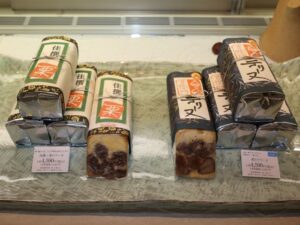
投稿タイプ:restaurants
Adachi Otoemon
Tamba chestnuts are a traditional product in Kyoto Prefecture whose history is as long as other well-known Kyoto traditional vegetables. Tamba chestnuts are from the Tamba region, which includes Kameoka, the Funai region, Ayabe, and Fukuchiyama. It’s said that in the old days of the Edo period (1603-1868), Tamba chestnuts were used as offerings, when the chestnuts were also accepted in place of the annual rice tax. Using these Tamba chestnuts, Adachi Otoemon crafts specialty dessert terrines and pound cakes here in Fukuchiyama City. Cross sections of the desserts reveal large, whole chestnuts, which are combined with the wasanbon Japanese refined sugar from the Sanuki region and flavourful cultured butter to create an exquisite product. You can really enjoy the chestnuts as they make up more than two thirds of the weight of this luxurious dessert. Additionally, the shop building was previously the residence of the Matsumura family, built during the Taisho (1912-1926) and Meji era (1868-1912) and is designated as one of Kyoto Prefecture’s Tangible Cultural Properties. Other than the chestnut terrines and chestnut pound cakes, there are also other baked goods, cream puffs, and gelato available.